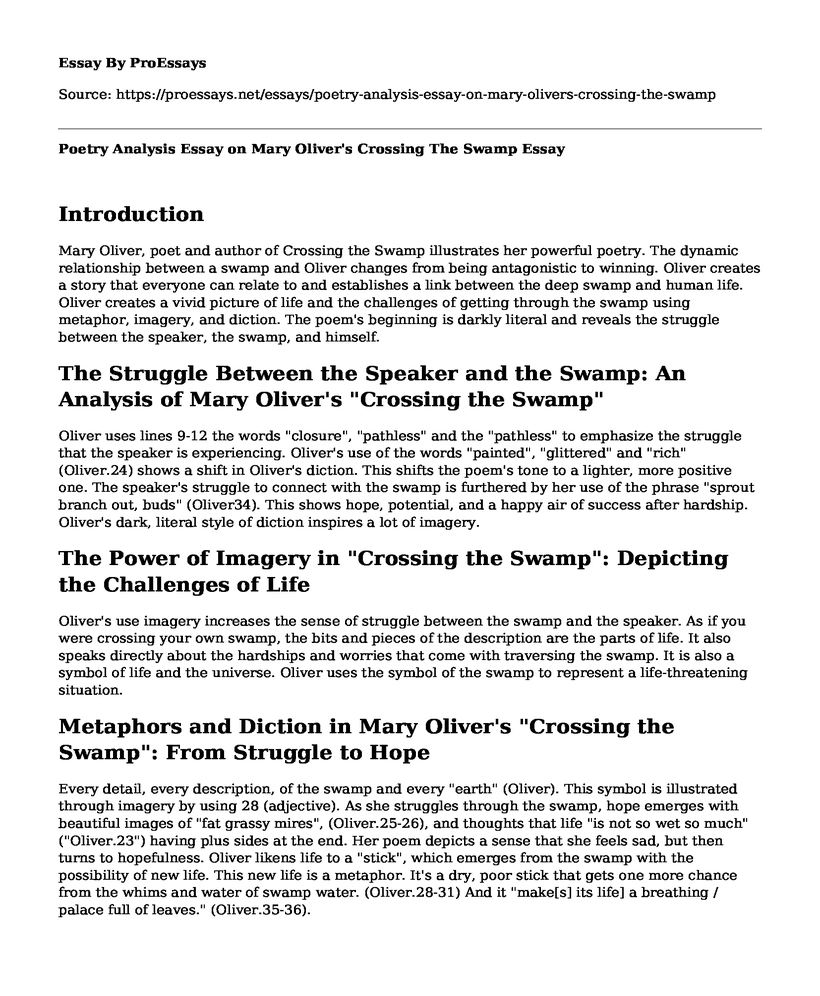Introduction
Mary Oliver, poet and author of Crossing the Swamp illustrates her powerful poetry. The dynamic relationship between a swamp and Oliver changes from being antagonistic to winning. Oliver creates a story that everyone can relate to and establishes a link between the deep swamp and human life. Oliver creates a vivid picture of life and the challenges of getting through the swamp using metaphor, imagery, and diction. The poem's beginning is darkly literal and reveals the struggle between the speaker, the swamp, and himself.
The Struggle Between the Speaker and the Swamp: An Analysis of Mary Oliver's "Crossing the Swamp"
Oliver uses lines 9-12 the words "closure", "pathless" and the "pathless" to emphasize the struggle that the speaker is experiencing. Oliver's use of the words "painted", "glittered" and "rich" (Oliver.24) shows a shift in Oliver's diction. This shifts the poem's tone to a lighter, more positive one. The speaker's struggle to connect with the swamp is furthered by her use of the phrase "sprout branch out, buds" (Oliver34). This shows hope, potential, and a happy air of success after hardship. Oliver's dark, literal style of diction inspires a lot of imagery.
The Power of Imagery in "Crossing the Swamp": Depicting the Challenges of Life
Oliver's use imagery increases the sense of struggle between the swamp and the speaker. As if you were crossing your own swamp, the bits and pieces of the description are the parts of life. It also speaks directly about the hardships and worries that come with traversing the swamp. It is also a symbol of life and the universe. Oliver uses the symbol of the swamp to represent a life-threatening situation.
Metaphors and Diction in Mary Oliver's "Crossing the Swamp": From Struggle to Hope
Every detail, every description, of the swamp and every "earth" (Oliver). This symbol is illustrated through imagery by using 28 (adjective). As she struggles through the swamp, hope emerges with beautiful images of "fat grassy mires", (Oliver.25-26), and thoughts that life "is not so wet so much" ("Oliver.23") having plus sides at the end. Her poem depicts a sense that she feels sad, but then turns to hopefulness. Oliver likens life to a "stick", which emerges from the swamp with the possibility of new life. This new life is a metaphor. It's a dry, poor stick that gets one more chance from the whims and water of swamp water. (Oliver.28-31) And it "make[s] its life] a breathing / palace full of leaves." (Oliver.35-36).
By reaching out for a second chance, you show faith in fate by having "one more chance at the whims of life" (Oliver.30). A "stick" can literally mean that it is not possible to reproduce or grow into another tree. It is a piece of a tree that has been cut and left to decay. The metaphor of the stick's rebirth, illustrated in the poem, refers to the emotional rebirth that occurs when someone goes from being depressed or stressed to being full of life and joy.
Conclusion
Oliver's use of imagery, metaphors, and diction shows that the relationship between speaker and swamp is one of struggle. Both are trying to destroy the other and win, but they eventually give in to their mutual needs. This dark, evocative diction is filled with imagery that shows that even in the depths the swamp, there is still hope. The swamp can be described as endless and difficult to traverse, with the same idea being transmitted into a person's life. This person must give all he or she can to make the "endless" (Oliver.1) path possible.
Cite this page
Poetry Analysis Essay on Mary Oliver's Crossing The Swamp. (2022, Aug 03). Retrieved from https://proessays.net/essays/poetry-analysis-essay-on-mary-olivers-crossing-the-swamp
If you are the original author of this essay and no longer wish to have it published on the ProEssays website, please click below to request its removal:
- Form, Sexuality, and Supernatural in Sir Gawain and the Green Night and John Donne's The Flea
- A Defense of Virginia and the South Book by Robert Lewis Dabney Essay
- Critical Essay on Concept of Cultural Identity in a Raisin in the Sun
- The Development of the Characters in Homer's Iliad Essay Example
- Essay Sample on Romeo and Juliet: A Tale of Forbidden Love
- American Realism: A Faithful Representation of Reality - Essay Sample
- Paper Example on Two Short Stories: Everyday Use and A Rose for Emily







